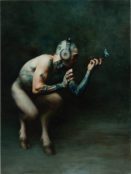[dropcap style=”font-size:100px;color:#992211;”]T[/dropcap]his March the New Scientist published four articles on Dreaming, an extract from ‘Why dreaming is vital: Unlocking the power of REM sleep’ is below and the contents of all four of the articles is fascinating. The New Scientist though has a rather empirical bent, nothing wrong in that but in order to bring a little balance and to do justice to the grandfather of dream theory we felt that Freud deserved another look, his ideas penetrating much deeper with far less machinery to hand may still be the best research into dreaming we have! you be the Judge.
_________________________________________________________
New Scientist excerpt,
“Dreams play a key role in boosting creative thought, memory, learning and even mental health. Now modern life may be cutting them short, with serious consequences…YOU know that feeling when someone wakes you up in the middle of a really good dream? There is a real sense of loss, like ending a TV episode on a cliffhanger. You want to jump back in, but no such luck. That is me every morning. I have a baby sleeping in the same room and am wrenched awake early each day, often mid-dream.That might sound like a trivial complaint. We tend to think of dream sleep as unimportant, the poor relative of vital and restorative deep sleep. But now it seems that dreams are much more than mystical night-time adventures. Recent research suggests that rapid eye movement (REM) sleep – when we have the most powerful dreams – is vital to learning and creativity, and promotes a healthy mind in a variety of ways. It isn’t romantic whimsy to say that if we stifle our dreams, we aren’t going to reach our potential,”
__________________________________________________________
The Interpretation of Dreams
Freud published ‘The Interpretation of Dreams’ in 1900 its effects and the ensuing effects of Psychoanalysis have been profound on culture shifting not only our understanding of human behaviour; the arena in which Freud principally wanted to make headway that is in the treatment of neurotics and hysterical symptoms, but also posing questions for philosophy, politics and art.
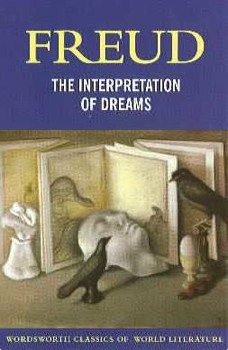
The Wordsworth Classic front cover
Freud’s writing style is personal not unlike a diary, drawing upon his interests and personal experiences. It is in this way that Freud developed his theory of dreams by keeping a journal of his dreams and later subjecting them to analysis. The dreams then serve to illustrate some of his theories. Freud’s structure for this which he repeats many times is as follows,
Preliminary Statement. In which Freud gives some context for the dream i.e. his age at the time of the dream any prior significant events which were pressing him and so on.
The Dream. Where the details of the dream itself are relayed as they are initially remembered.
Analysis. Where Freud employs his technique to elaborate on the meaning of the dream and its significant content. In this tradition then I will recount one of my own dreams and through its analyses we may understand some of the key ideas which Freud employed;
Analysis of a specimen Dream
Preliminary statement
The dream I will recount I remember from 1989 I was nine, the following events were paramount to me at that time.
- My parents were preparing to move the family from Newcastle to London and I and my younger brother were upset at the idea of being taken away from our school friends, the both of us protested to no avail and plans were firmly put in place.
- In the process of packing up the house some old pictures in a family album were found by my younger brother and he inquired about a young girl of whom there were many pictures but who he had never known, (The pictures were of my young aunt who had died a year before he was born)
- It had also been an issue that I had grave problems in the study of maths which both my father and his father valued in much higher esteem then what for them was childish play i.e. my interest in drawing and painting. I had attempted to get support and reassurance from my mother and grandmother but to my frustration they shared the same view as the men.
The Dream
I am in the dining room of my family home sitting at the table with my father and younger brother; we are waiting for my mother who is in the kitchen to bring us sandwiches. My mother calls from the kitchen, ‘do you want tomato sauce with yours,’ she is addressing me, I am annoyed by the question, doesn’t she know me at all, I think, since I always complain about how disgusting I find food covered in sauce.
To my surprise my mother appears from the kitchen not at all dressed like herself but rather primly with her hair tied back in a bun and a blue floral dress, she is carrying a tray and places it in the centre of the table.
I’m shocked to see the bottle is blue not red at all and further confused that no-one else finds this odd, watching my family I begin to feel afraid until I finally say ‘stop eating it’ but they laugh at me and I notice that their eyes are all black with no other pigment at all. I’m told to eat my food by my father at this I run away from the table, as I look back I feel guilty that I left my brother eating the sauce. On the way out of the house I come to the top of the stairs and notice that my childhood pram is at the foot of the stairs I feel disappointed and say to my self ‘she’s not there’ I start down the stairs and out of the front door into the street, I am dizzy and gasping, no one is around and no one comes out of the house I run aimlessly around the empty streets, then I wake up.
The Analysis
Firstly we find the material for the dream in the previous day, Freud writes,
‘When in a dream something has the character of a spoken utterance-that is, when it is said or herd, not merely thought- and the distinction can usually be made with certainty- then it originates in the utterances of waking life, which have, of course been treated as raw material,’ Freud
It was common for my mother to repeat every night, ‘would I like sauce’ and it frustrated me greatly that she would treat me like a stranger, here we have the actual statement which has in the dream been given an uncanny twist and as a revenge I make my family strangers who behave oddly and have black eyes, as if I am saying it is you all who are strange not I.
It is possible also that I may have spoken the words, ‘stop eating it’ to my brother, I recall it always irritated me that he accepted the condiment especially when I declined, but my memories fail me here so we shall have to be satisfied with the origin of the first statement. The dream also re stages the site of a conversation from the previous day regarding my aunt, I recall my mother showing my brother pictures of her younger sister who had lived with us for a time until her death from a car accident, my brother was fascinated by the pictures as they showed our home with this intruder he had never known so this accounts for the location and the statement.
How then is it possible to relate such an uncomfortable and anxiety ridden dream to Freud’s theory of wish fulfilment? Upon examining the manifest content an explanation is simple enough, although not entirely satisfying; It would go as follows, I am frustrated by my mother and father and grandparents who for various aforementioned reasons have acted in ways which irritate me. Thus it is my wish to see myself as separate, as independent from them, there actions which annoy me in real life are here displaced and condensed into the bottle which has the character of an ‘unheimlich’ object, that is it is familiar and yet alien just as my family seemed to me at that time. The anxiety is easy enough to explain then, it is ‘existential’ Sartre writes,
‘Man is condemned to be free; because once thrown into the world,
he is responsible for everything he does’ Sartre,
‘Existentialism Is a Humanism’
lecture 1946 transcript obtained at www.marxists.org.
Perhaps it is this which is the dreams insight? It is as if a wish for freedom from the control of others is a wish for the dread of having to make autonomous decisions. The fear results from freedom, from running away from my patriarchal family which has guaranteed meaning in my young life, surely this would make any nine year old dizzy with responsibility.
However Freud would not be satisfied with this analysis to give a proper Freudian twist we need only to heed Freud’s own words and dig deeper for the latent content,
‘We may deduce the doctrine that anxiety dreams are dreams of sexual content, and that the libido appertaining to this content has been transformed into anxiety …..In my further attempts to arrive at a theory of dreams I shall again have the occasion to revert to the conditions of anxiety dreams and their compatibility with the theory wish fulfilment,’ Freud ‘The Interpretation of Dreams’ pg69
There remain two elements to understand, firstly, my mother appeared ‘primly’ dressed, in fact I recall that her dress within the dream is similar to one worn be my grandmother and her hair pulled into bun also resembles my paternal grandmother so my unconscious has condensed these maternal figures into one, both of whom I am disappointed in.
My mother who usually opposes my grandmother is in this instance in agreement, my mind then makes them the same person since there crime is the same they are with my father and grandfather against me, the actions of my mother in the dream support this, she behaves strangely, like a ‘Stepford wife’ and offers me food which disgusts me.
It is not a great leap to connect the appetite for food to the libido since for Freud a laid table would represent a female body and the bottle an obvious phallic object, what I flee from here is the un-winnable maternal object, tainted as it is by paternal authority It disgusts me now, what I find is another model of womanhood but she’s ‘not there’ this brings me to my second point, the appearance of the pram at the foot of the stairs and my thought that, she is not there.
I recall that the last time I saw my aunt (who my mother had been discussing with my brother the previous day) My aunt had been living with us and had been left to look after me, she being Twelve and I four, it was her game to hide so I could look for her and on this occasion she did so behind my pram I thought she had gone and I became upset, when she appeared I was relieved, fearing I would get her into trouble she asked me not to tell my parents who had arrived home, she left and waved me goodbye, this was the final time I would see her, It is not inconceivable that I might have attached to this girl what for Freud is generally associated with the mother, that being Oedipal desire this would certainly be supported by my running down stairs towards the place I last saw her,
‘To the appearance of steps, staircases and ladders in dreams, and were soon in a position to show that staircases (and analogous things) were unquestionably symbols of copulation. It is hard not to discover the basis of the comparison: we come to the top in a series of rhythmical movements and with increasing breathlessness and then with a few leaps we get to the bottom again. Thus the rhythmical pattern of copulation is reproduced,’ Freud ‘The Standard Edition of the Complete Psychological Works of Sigmund Freud’ pg355
Could it be then what I feel upon fleeing the house is not the brooding romantic notion of freedom as defined by Sartre but rather the aimlessness of a subject deprived of its object of desire, desperate to find a replacement, a model which would guarantee meaning again?
We have some understanding then of the terms that Freud used to describe the unconscious mechanisms employed in dream those being, condensation, where one thing represents many things, Freud’s own example is that of a figure who embodies both his uncle and his friend from the dream of Irma’s injection.
Displacement, when one thing stands in for another, the dreamers feelings toward this thing are meant for the latent target i.e. the blue bottle from my dream is the target of my resentment and the locus of my anxiety both emotions I felt towards my family in waking life.
Representation, where a feeling such as coldness or dizziness is symbolic of a state in waking life i.e. cold for isolated or dizzy for confused or unsure, In this instance however its important to note that the symbolic attachments would be different for each subject, this is one of the reasons coded dream books are useless since they don’t address the individuals symbolic language and depend on generalisations.
Perhaps the most significant idea which would radiate from ‘The Interpretation of Dreams’ and resonate in popular culture was that of sexual desire both explicit and latent, which hitherto was approached less directly in western culture, Freud writes,
‘Dreams which are apparently guileless turn out to be the reverse of innocent if one takes the trouble to interpret them; if I may be permitted the expression, they all show ‘the mark of the beast’ Freud ‘The Interpretation of Dreams’ pg86
Freud’s implication was not only do dreams come from the inside, the unconscious, rather then from outside supernatural forces, they are often sexual either openly or in a disguised form but more radically that they represent a fulfilled wish from some part of the dreamer, and that we all have them! The combination of these factors we can imagine might upset individuals who found Freud’s theory base and overtly sex obsessed.
Not so the surrealists who wholeheartedly embraced Freud’s theory the images in their work and right across the art world would shift from religious and mythological sexuality to an exploration of the inner sexual life of themselves and people in general. we might see this shift if we compare the following image from Henry Fuseli ‘Nightmare’ 1781 with that of Max Klingers ‘The Dead Mother’ 1908, Kilnger is considered a key influence on many surrealists notably Giorgio de Chirico, in Kilnger’s image the familial/secular lens has superseded the religious one.
This is also evident in artists such as Hieronymus Bosch who otherwise prefigured and anticipated surreal aesthetics, Bosch very much an outsider remained a man of his time however in the respect that his subjects came from religious material.

The Garden of Earthly Delights. 1503-1504
Before Freud, Dali’s ‘Virgin auto-sodomised by her own chastity’ would not have been possible, for better or worse we might say Freud represented a tipping point for the surrealists his ‘Interpretation of dreams’ releasing them once an for all from religion and in which man emerged as the great undiscovered country of the twentieth century.
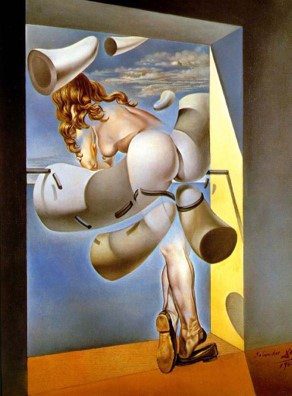
‘Young Virgin Auto-Sodomized by the Horns of Her Own Chastity’, Dali, 1954
The founder of surrealism Andre Breton had training in psychiatric methods as he had worked at an institution treating soldier’s home from the front and read with enthusiasm the work of Freud. Breton openly credited Freud and attempted to involve Freud in a book he was writing, ‘Les vases communicants,’ which collected together the dreams of surrealist artists, Freud however was unenthusiastic about his popularity among surrealists a row with Breton over an omitted citation possibly soured the relationship after this Breton wrote,
‘It goes without saying that I never insinuated that Freud had deliberately calculated to keep silent the work of a man to whom he could be intellectually indebted. An accusation of such magnitude would be in opposition to the high esteem that I have for him’
Freud however was less genial and maintained that although the surrealists produced great works those works were not of the unconscious,
‘Freud initiated the psychoanalytic critique of Surrealism with his remark that what interested him most about the Surrealists was not their unconscious but their conscious… In this view, the Surrealists may have been producing great works, but they were products of the conscious, not the unconscious mind, and they deceived themselves with regard to what they were doing with the unconscious. In psychoanalysis proper, the unconscious does not just express itself automatically but can only be uncovered through the analysis of resistance and transference in the psychoanalytic process,’ Jahsonic Criticism of Surrealism, obtained at www.artandpopularculture.com/Jahsonic.
Never the less Freud’s influence in art persisted, It would seem that Breton’s idea that Freud would be assimilated to his cause was an underestimation of Freud’s commitment to the validity of his own theory and possibly rather arrogant since Freud was well established at this time and Surrealism had yet to show its colour’s, so to speak.
Since the time of ‘The Interpretation of Dreams’ publication Freud’s techniques on Dream analysis have come in for considerable criticism, while much of this is motivated by a desire to discredit Freud for reasons which do not pertain to the pursuit of improving the cannon of understanding on dream study, for example critics who denounce Freud for making everything about sex as if he himself had established sexual symbolism, an argument taken up by Stephen Wilson in the introduction to 1997 Wordsworth edition of ‘The Interpretation of Dreams’
‘Such symbolism, as Freud points out, has been prevalent in folklore, myths, legends, idiomatic phrases, proverbs and witticisms since time immemorial. Freud merely extended the list to include dreams,’ Stephen Wilson, ‘The Interpretation of Dreams’ pg11
Despite Wilson’s attempt to exonerate Freud from responsibility for making everything about sex Freud remains very much in this mould for many people, other critics do seem genuinely tempered and fair in their criticisms for example Richard Webster writing in, ‘Why Freud Was Wrong, addresses the issue that Freud had fallen under the influence of his eccentric Friend Wilhelm Fliess an otolaryngologist (nose ear and throat Dr)
‘In this respect Freud was submitting once again to what was perhaps the single most characteristic impulse in his scientific imagination, the longing to be able to open all secrets with a single key,’ Richard Webster ‘Why Freud Was Wrong’ pg260
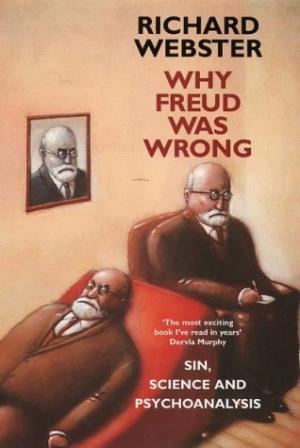
Here Webster is referring to Freud’s notion that dreams are examples of fulfilled wishes on the part of the dreamer he goes on to accuse Freud as a master of Hermeneutics (interpretation theory) that he abused and manipulated symbols create persuasive rather than scientific arguments,
‘Freud juggled with symbols in a similar way that even the most apparently frustrating, tragic or pessimistic dreams could be interpreted as secretly fulfilling some wish or desire of the dreamer,’ Richard Webster ‘Why Freud Was Wrong’ pg264
This argument however seems obtuse since wish fulfilment must always be understood alongside ambivalence; ambivalence not only applies to others but also to one’s self, which one can both love and hate as easily as we do other people.
Subscribing then to the idea that not all dreams revolve around sex, since death, fear and loneliness seem equally important in the human psyche is less controversial then throwing out Freud’s theory of ‘wish fulfilment’.
Isn’t it intuitively known to us all that despite our evolved fear of death we still over eat, smoke, drink and take unnecessary risks, perhaps all of the above, is it so hard to believe in light of this that there is a little part of us which relishes, wishes even for death?
Webster’s most convincing arguments however against Freud are as follows,
- that Freud seemed to allow himself an unrealistic level of authority, Webster evokes the criticism of W.H.R Rivers an English Psychiatrist who otherwise sympathetic to Freud writes,
‘Such a method’ wrote Rivers, ‘would reduce any other science to an absurdity, and doubts must be raised whether psychology can have methods of its own which would make it necessary to separate it from all other science and put it in a distinct category’ Webster quoting Rivers ‘Why Freud Was Wrong’ pg265
It’s true that Freud had a huge authority and that the credibility of Psychoanalysis had and would suffer from internal conflict, making it seem a method used by charismatic agents to push their personal agenda’s rather than a science proper. This ambiguity it the classification of Psychoanalysis however would ensure it a distinct category of its own and while Webster clearly feels that is untenable it is for others it be Psychoanalysis’s saving grace that it couldn’t be fully legitimised as a science Freud writing of his critics states,
‘A brilliant example of the aversion to learning anything new so characteristic of the scientist,’ Freud ‘The Interpretation of Dreams’ pg9
In this edition which appears in a later German print we have a hint perhaps that Freud had abandoned any ideas of being embraced by the established scientific community.
- That Freud presented a totally un-falsifiable system even to the extent that in dreams where it would seem impossible to interpret the meaning as fulfilling a wish Freud posited that the wish of the dreamer was in fact to prove him wrong bringing the rouge dream back within Freud’s theory.
Even for those sympathetic to Freud and taking into account the resistances of the analysed this does seem an overtly slippery strategy and one which understandably frustrated Webster and Freud’s critics alike.
To conclude however I would like to challenge one of Webster’s key statements Webster states of Psychoanalysts that,
‘The Psychoanalysts job was to strip the dream symbols of their disguise and thus recover the pristine wishes and desires which they concealed,’ Webster, ‘Why Freud Was Wrong’ pg261.
At first this seems evidently true but it represents a gross simplification on Webster’s part akin only to the oversights Webster himself accuses Freud of allowing. A close analysis of this brief statement shows a gaping lack of knowledge about the therapeutic relationship it is not that I hand my coded dream to the analyst and ask he or she to return to me my truth as it were.
That would imply a universal established language of symbols of the kind Freud denounces in the introduction of ‘The Interpretation of Dreams’ but rather that in speaking to the therapist about my dream in the course of what Freud calls the ‘Dream work’ insight into my unconscious mechanisms become more obvious to us both, in light of this Webster’s simplification seems manipulative encouraging an exaggerated view of the analyst highlighting arrogance.
In fact the therapist knows nothing he or she is simply a catalyst for knowledge which the analysand holds but cannot face or bring to the surface accept in the form of symptoms, the psychoanalyst must manage a complex relationship in which his client assumes his deep insight while denying their own unconscious, the therapeutic relationship is key.
___________________________________________
Some tactics to look out for in the recording of your own dreams
Louise Bourgeois and Man Ray, Anthony Gormley and Damien Hirst all recorded their dreams to aid the artistic process, some methods below to aid those above in your own attempts at dream interpretation.
In his book The Interpretation of Dreams, Sigmund Freud suggested that the content of dreams is related to wish fulfilment. Freud believed that the manifest content of a dream, or the actual imagery and events of the dream, served to disguise the latent content, or the unconscious wishes of the dreamer.
Freud also described four elements of this process that he referred to as ‘dream work’:
- Condensation – Many different ideas and concepts are represented within the span of a single dream. Information is condensed into a single thought or image.
- Displacement – This element of dream work disguises the emotional meaning of the latent content by confusing the important and insignificant parts of the dream.
- Symbolisation – This operation also censors the repressed ideas contained in the dream by including objects that are meant to symbolise the latent content of the dream.
- Secondary Revision – During this final stage of the dreaming process, Freud suggested that the bizarre elements of the dream are reorganised in order to make the dream comprehensible, thus generating the manifest content of the dream.
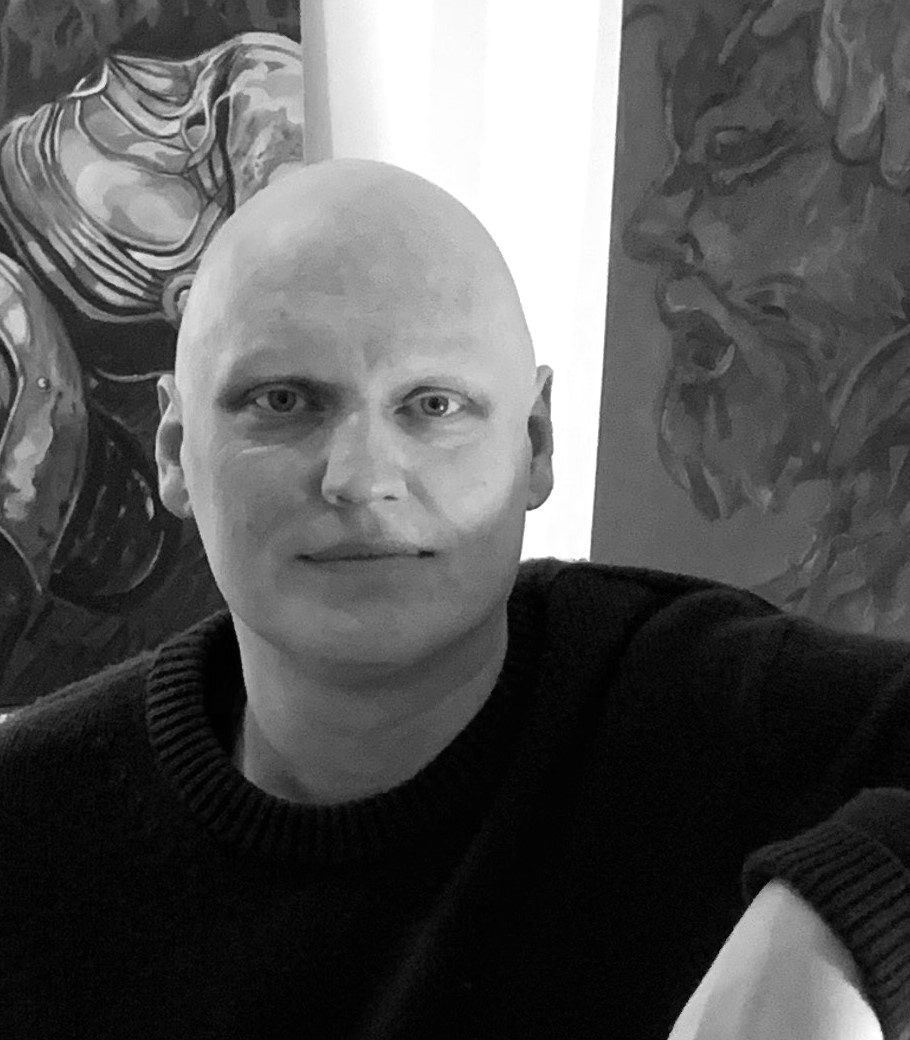
Michael Eden is a visual artist, researcher and writer at the University of Arts London exploring relationships between monstrosity, subjectivity and landscape representation.






